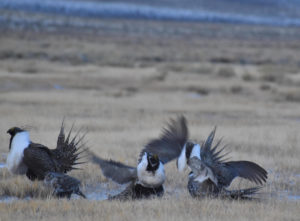For Immediate Release, March 20, 2019
| Contacts: | Michael Robinson, Center for Biological Diversity, (575) 313-7017, michaelr@biologicaldiversity.org Mary Katherine Ray, Rio Grande Chapter Sierra Club, (575) 772-5655, mkrscrim@gmail.com Maggie Howell, Wolf Conservation Center, (914) 763-2373, maggie@nywolf.org Greta Anderson, Western Watersheds Project, (520) 623-1878, greta@westernwatersheds.org |
SILVER CITY, N.M.— Thirty-seven organizations today sent a letter urging the U.S. Fish and Wildlife Service to free two endangered wolves trapped in New Mexico and halt additional trapping.
Federal trappers recently removed two Mexican gray wolves from the wild and set traps for a third wolf for preying on cattle in the Gila National Forest. Because the removals undermine wolf recovery, today’s letter urges the Service to cancel the removal order and promptly release the captured wolves.
“Wolves can’t be recovered with traps and bullets,” said Michael Robinson, senior conservation advocate with the Center for Biological Diversity. “Mexican wolves are closer to extinction than the government admits. Removing wolves to placate the livestock industry is the last thing we should be doing to this profoundly endangered population.”
The Fish and Wildlife Service has refused to release its removal order to the public. But the agency has acknowledged that the order authorizes the killing of a wolf or multiple wolves.
“Given the excessive losses to the wolf population in the last year from unlawful killing, traps and other unknown causes, it’s crucial that this wolf’s life be spared,” said Mary Katherine Ray, wildlife chair for the Rio Grande Chapter of the Sierra Club. “A kill order is contrary to the goal of the recovery of this highly imperiled species.”
The Mexican wolf is one of the most endangered mammals in North America, with two reintroduced populations in Mexico and the U.S. Southwest, and roughly 300 captive wolves.
Federal trapping and shooting on behalf of the livestock industry has kept the population low since reintroduction began in Arizona and New Mexico in 1998. In 2017, 114 wolves were counted in the wild. The Fish and Wildlife Service will soon release 2018 numbers. In Mexico, approximately 35 wolves stem from a reintroduction program begun in 2011.
“Any loss to the wild population is a step backward for Mexican wolf recovery,” stated Maggie Howell, director of the Wolf Conservation Center. “The Fish and Wildlife Service should be releasing captive wolves into the wild as recommended by scientists, not taking critically endangered lobos out.”
“This area is good habitat for wolves, but clearly not such a great place for livestock,” said Greta Anderson, deputy director of Western Watersheds Project. “Real conflict reduction would mean permanently closing the allotment and allowing wildlife to be wild on our public lands.”
The letter from conservation groups points out the inequity in the Service ignoring the advice of scientists and allowing wolves to scavenge on livestock carcasses, and then scapegoating wolves when they begin to prey on cattle near where they scavenged.
It is not known if those circumstances precipitated the present conflicts. But in the past, Rainy Mesa has seen repeated incidents of cattle dying from non-wolf causes and then being scavenged by wolves. Wolves then began preying on livestock and suffered the consequences.





